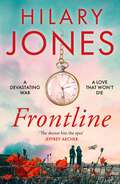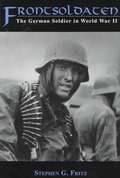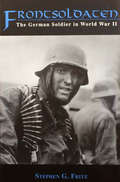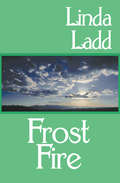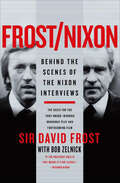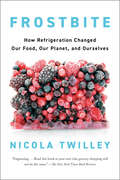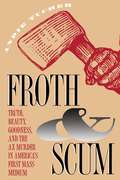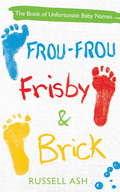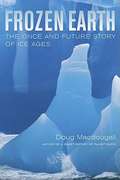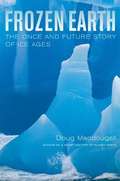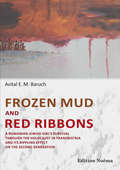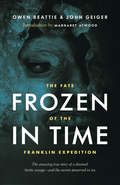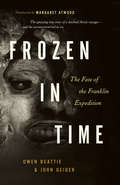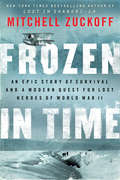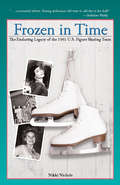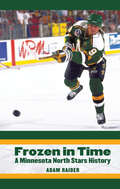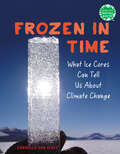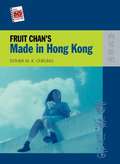- Table View
- List View
Frontline: The sweeping WWI drama that 'deserves to be read' - Jeffrey Archer
by Hilary Jones'The doctor hits the spot and deserves to be read' - Jeffrey Archer 'A story to get the heart racing' - Daily Express 'An enthralling tale' - Daily Mirror 'Dr Hilary is a master storyteller' - Lorraine Kelly CBE ___________LOVE GAVE THEM STRENGTH. LOVING EACH OTHER GAVE THEM COURAGE. Britain and her allies are engaged in a long war with Germany.Grace is the daughter of landed gentry, volunteering as a nurse on the Western Front.Will is the son of a dockworker, driven to enlist by a sense of patriotism and the thrill of adventure.When their lives collide in a field hospital in France, they form a passionate connection.This is a sweeping and sumptuous WW1 drama and historical epic, perfect for fans of Ken Follett, Kate Mosse and Jeffrey Archer.
Frontline: The sweeping WWI drama that 'deserves to be read' - Jeffrey Archer
by Hilary Jones'The doctor hits the spot and deserves to be read' - Jeffrey Archer 'A story to get the heart racing' - Daily Express 'An enthralling tale' - Daily Mirror 'Dr Hilary is a master storyteller' - Lorraine Kelly CBE ___________LOVE GAVE THEM STRENGTH. LOVING EACH OTHER GAVE THEM COURAGE. Britain and her allies are engaged in a long war with Germany.Grace is the daughter of landed gentry, volunteering as a nurse on the Western Front.Will is the son of a dockworker, driven to enlist by a sense of patriotism and the thrill of adventure.When their lives collide in a field hospital in France, they form a passionate connection.This is a sweeping and sumptuous WW1 drama and historical epic, perfect for fans of Ken Follett, Kate Mosse and Jeffrey Archer.
Frontsoldaten: The German Soldier in World War II
by Stephen G. FritzIn exploring the reality of the Landser, the average German soldier in World War II, through letters, diaries, memoirs, and oral histories, Stephen G. Fritz provides the definitive account of the everyday war of the German front soldier. The personal documents of these soldiers, most from the Russian front, where the majority of German infantrymen saw service, paint a richly textured portrait of the Landser that illustrates the complexity and paradox of his daily life.
Frontsoldaten: The German Soldier in World War II
by Stephen G. Fritz&“Drawn from letters, diaries and memoirs, this impressive study presents a rounded, detailed picture of the daily life&” for frontline Nazi soldiers (Publishers Weekly). Stephen G. Fritz explores the day-to-day reality of the average German infantryman—or Landser—during World War II. Through letters, diaries, memoirs, and oral histories, most of which describe life on the Russian front, Fritz presents a richly textured portrait of the Landser that illustrates the complexity and paradox of his daily life. Although clinging to a self-image as a decent fellow, the German soldier nonetheless committed terrible crimes in the name of The Third Reich. When the war was finally over, and his country lay in ruins, the Landser faced a bitter truth: all his exertions and sacrifices had been in the name of a deplorable regime that had committed unprecedented crimes. With chapters on training, images of combat, living conditions, combat stress, the personal sensations of war, the bonds of comradeship, and ideology and motivation, Fritz reveals war through the eyes of these self-styled &“little men.&”
Frost Fire (The Fire Trilogy)
by Linda LaddThe Fire Trilogy ignites with one woman&’s quest for Civil War vengeance—&“packed with subplots and supporting characters that keep the action percolating&” (Publishers Weekly). Join Linda Ladd in this first book of an exciting trilogy as she takes you on an incredible journey from the terrors of war to the comforts of love. She is intent on avenging her dishonor by the man who had taken more from her than she could ever possibly imagine. She has nothing, and so there is nothing she can lose, but she is intent on using any means necessary to take back what is rightfully hers. Born out of the ravages of war, theirs is a love that cannot be denied, blurring the boundaries forged by conflict until both are on the edge of a dizzying abyss where only passion matters, and surrender is sweet.
Frost/Nixon: Behind the Scenes of the Nixon Interviews
by David Frost Bob ZelnickThe British journalist recounts his 1977 interview with the disgraced American president—the basis for the Tony Award–winning play & Oscar-nominated film.In Frost/Nixon, Sir David Frost tells the extraordinary story of how he pursued and landed the biggest fish of his career—and how the series drew larger audiences than any news interview ever had in the United States, before being shown all over the world.This is Frost’s absorbing story of his pursuit of Richard Nixon, and is no less revealing of his own toughness and pertinacity than of the ex-President’s elusiveness. Frost’s encounters with such figures as Swifty Lazar, Ron Ziegler, potential sponsors, and Nixon as negotiator are nothing short of hilarious, and his insight into the taping of the programs themselves is fascinating.Frost/Nixon provides the authoritative account of the only public trial that Nixon would ever have, and a revelation of the man’s character as it appeared in the stress of eleven grueling sessions before the cameras. Including historical perspective and transcripts of the edited interviews, this is the story of Sir David Frost’s quest to produce one of the most dramatic pieces of television ever broadcast, described by commentators at the time as “a catharsis” for the American people.
Frostbite: How Refrigeration Changed Our Food, Our Planet, and Ourselves
by Nicola TwilleyWinner of the James Beard Award for Literary Writing "Engrossing...hard to put down." — The New York Times Book Review&“Frostbite is a perfectly executed cold fusion of science, history, and literary verve . . . as a fellow nonfiction writer, I bow down. This is how it's done.&” — Mary Roach, author of Fuzz and StiffAn engaging and far-reaching exploration of refrigeration, tracing its evolution from scientific mystery to globe-spanning infrastructure, and an essential investigation into how it has remade our entire relationship with food—for better and for worseHow often do we open the fridge or peer into the freezer with the expectation that we&’ll find something fresh and ready to eat? It&’s an everyday act—but just a century ago, eating food that had been refrigerated was cause for both fear and excitement. The introduction of artificial refrigeration overturned millennia of dietary history, launching a new chapter in human nutrition. We could now overcome not just rot, but seasonality and geography. Tomatoes in January? Avocados in Shanghai? All possible.In Frostbite, New Yorker contributor and cohost of the award-winning podcast Gastropod Nicola Twilley takes readers on a tour of the cold chain from farm to fridge, visiting off-the-beaten-path landmarks such as Missouri&’s subterranean cheese caves, the banana-ripening rooms of New York City, and the vast refrigerated tanks that store the nation&’s orange juice reserves. Today, nearly three-quarters of everything on the average American plate is processed, shipped, stored, and sold under refrigeration. It&’s impossible to make sense of our food system without understanding the all-but-invisible network of thermal control that underpins it. Twilley&’s eye-opening book is the first to reveal the transformative impact refrigeration has had on our health and our guts; our farms, tables, kitchens, and cities; global economics and politics; and even our environment.In the developed world, we&’ve reaped the benefits of refrigeration for more than a century, but the costs are catching up with us. We&’ve eroded our connection to our food and redefined what &“fresh&” means. More important, refrigeration is one of the leading contributors to climate change. As the developing world races to build a US-style cold chain, Twilley asks: Can we reduce our dependence on refrigeration? Should we? A deeply researched and reported, original, and entertaining dive into the most important invention in the history of food and drink, Frostbite makes the case for a recalibration of our relationship with the fridge—and how our future might depend on it.
Froth and Scum
by Andie TucherTwo notorious antebellum New York murder cases--a prostitute slashed in an elegant brothel and a tradesman bludgeoned by the brother of inventor Samuel Colt--set off journalistic scrambles over the meanings of truth, objectivity, and the duty of the press that reverberate to this day. In 1833 an entirely new kind of newspaper--cheap, feisty, and politically independent--introduced American readers to the novel concept of what has come to be called objectivity in news coverage. The penny press was the first medium that claimed to present the true, unbiased facts to a democratic audience. But in Froth and Scum, Andie Tucher explores--and explodes--the notion that 'objective' reporting will discover a single, definitive truth. As they do now, news stories of the time aroused strong feelings about the possibility of justice, the privileges of power, and the nature of evil. The prostitute's murder in 1836 sparked an impassioned public debate, but one newspaper's 'impartial investigation' pleased the powerful by helping the killer go free. Colt's 1841 murder of the tradesman inspired universal condemnation, but the newspapers' singleminded focus on his conviction allowed another secret criminal to escape. By examining media coverage of these two sensational murders, Tucher reveals how a community's needs and anxieties can shape its public truths. The manuscript of this book won the 1991 Allan Nevins Prize of the Society of American Historians for the best-written dissertation in American history. from the book Journalism is important. It catches events on the cusp between now and then--events that still may be changing, developing, ripening. And while new interpretations of the past can alter our understanding of lives once led, new interpretations of the present can alter the course of our lives as we live them. Understanding the news properly is important. The way a community receives the news is profoundly influenced by who its members are, what they hope and fear and wish, and how they think about their fellow citizens. It is informed by some of the most occult and abstract of human ideas, about truth, beauty, goodness, and justice.
Frou-Frou, Frisby & Brick: The Book of Unfortunate Baby Names
by Russell AshFrou-Frou Mallett Extravaganza Tomkyns-Grafton Maniac Keene Reckless Baker If there's one thing guaranteed to make a child shrink into their seat during registration - it's a stupid name. Unfortunately for kids across the world, parents keeping making crimes against nomenclature. Fortunately for us, Russell Ash keeps collecting them. The perfect gift book for expectant parents, FROU-FROU, FRISBY & BRICK is a helpful guide to the sorts of names, or name combinations, to avoid at all costs.
Frou-Frou, Frisby & Brick: The Book of Unfortunate Baby Names
by Russell AshFrou-Frou MallettExtravaganza Tomkyns-GraftonManiac KeeneReckless BakerIf there's one thing guaranteed to make a child shrink into their seat during registration - it's a stupid name. Unfortunately for kids across the world, parents keeping making crimes against nomenclature. Fortunately for us, Russell Ash keeps collecting them.The perfect gift book for expectant parents, FROU-FROU, FRISBY & BRICK is a helpful guide to the sorts of names, or name combinations, to avoid at all costs.
Frozen
by Mary CasanovaSixteen-year-old Sadie Rose hasn&’t said a word in eleven years—ever since the day she was found lying in a snowbank during a howling storm. Like her voice, her memories of her mother and what happened that night were frozen. Set during the roaring 1920s in the beautiful, wild area on Rainy Lake where Minnesota meets Canada, Frozen tells the remarkable story of Sadie Rose, whose mother died under strange circumstances the same night that Sadie Rose was found, unable to speak, in a snowbank. Sadie Rose doesn&’t know her last name and has only fleeting memories of her mother—and the conflicting knowledge that her mother had worked in a brothel. Taken in as a foster child by a corrupt senator, Sadie Rose spends every summer along the shores of Rainy Lake, where her silence is both a prison and a sanctuary.One day, Sadie Rose stumbles on a half dozen faded, scandalous photographs—pictures, she realizes, of her mother. They release a flood of puzzling memories, and these wisps of the past send her at last into the heart of her own life&’s great mystery: who was her mother, and how did she die? Why did her mother work in a brothel—did she have a choice? What really happened that night when a five-year-old girl was found shivering in a snowbank, her voice and identity abruptly shattered?Sadie Rose&’s search for her personal truth is laid against a swirling historical drama—a time of prohibition and women winning the right to vote, political corruption, and a fevered fight over the area&’s wilderness between a charismatic, unyielding, powerful industrialist and a quiet man battling to save the wide, wild forests and waters of northernmost Minnesota. Frozen is a suspenseful, moving testimonial to the haves and the have-nots, to the power of family and memory, and to the extraordinary strength of a young woman who has lost her voice in nearly every way—but is utterly determined to find it again.
Frozen Chosin: U.S. Marines At The Changjin Reservoir [Illustrated Edition] (Marines In The Korean War Commemorative Series #7)
by Brigadier General Edwin H. SimmonsIncludes more than 40 maps, plans and illustrations.This volume in the official History of the Marine Corps chronicles the part played by United States Marines in the Chosin Reservoir Campaign.The race to the Yalu was on. General of the Army Douglas MacArthur's strategic triumph at Inchon and the subsequent breakout of the U.S. Eighth Army from the Pusan Perimeter and the recapture of Seoul had changed the direction of the war. Only the finishing touches needed to be done to complete the destruction of the North Korean People's Army. Moving up the east coast was the independent X Corps, commanded by Major General Edward M. Almond, USA. The 1st Marine Division, under Major General Oliver P. Smith, was part of X Corps and had been so since the 15 September 1950 landing at Inchon.After Seoul the 1st Marine Division had reloaded into its amphibious ships and had swung around the Korean peninsula to land at Wonsan on the east coast. The landing on 26 October 1950 met no opposition; the port had been taken from the land side by the resurgent South Korean army. The date was General Smith's 57th birthday, but he let it pass unnoticed. Two days later he ordered Colonel Homer L. Litzenberg, Jr., 47, to move his 7th Marine Regimental Combat Team north from Wonsan to Hamhung. Smith was then to prepare for an advance to the Manchurian border, 135 miles distant. And so began one of the Marine Corps' greatest battles--or, as the Corps would call it, the "Chosin Reservoir Campaign." The Marines called it the "Chosin" Reservoir because that is what their Japanese-based maps called it. The South Koreans, nationalistic sensibilities disturbed, preferred--and, indeed, would come to insist--that it be called the "Changjin" Reservoir.
Frozen Earth: The Once and Future Story of Ice Ages
by Doug MacdougallIn this engrossing and accessible book, Doug Macdougall explores the causes and effects of ice ages that have gripped our planet throughout its history, from the earliest known glaciation--nearly three billion years ago--to the present. Following the development of scientific ideas about these dramatic events, Macdougall traces the lives of many of the brilliant and intriguing characters who have contributed to the evolving understanding of how ice ages come about. As it explains how the great Pleistocene Ice Age has shaped the earth's landscape and influenced the course of human evolution, Frozen Earth also provides a fascinating look at how science is done, how the excitement of discovery drives scientists to explore and investigate, and how timing and chance play a part in the acceptance of new scientific ideas. Macdougall describes the awesome power of cataclysmic floods that marked the melting of the glaciers of the Pleistocene Ice Age. He probes the chilling evidence for "Snowball Earth," an episode far back in the earth's past that may have seen our planet encased in ice from pole to pole. He discusses the accumulating evidence from deep-sea sediment cores, as well as ice cores from Greenland and the Antarctic, that suggests fast-changing ice age climates may have directly impacted the evolution of our species and the course of human migration and civilization. Frozen Earth also chronicles how the concept of the ice age has gripped the imagination of scientists for almost two centuries. It offers an absorbing consideration of how current studies of Pleistocene climate may help us understand earth's future climate changes, including the question of when the next glacial interval will occur.
Frozen Earth: The Once and Future Story of Ice Ages
by Douglas MacdougallDoug Macdougall explores the causes and effects of ice ages that have gripped our planet throughout its history, from the earliest known glaciations -- nearly three billion years ago -- to the present.
Frozen Mud and Red Ribbons: A Romanian Jewish Girl's Survival through the Holocaust in Transnistria and Its Rippling Effect on the Second Generation (Edition Noema Ser.)
by Avital E. BaruchWhen Sophica was six years old, she was deported together with her mother and the whole of the Jewish community of Mihaileni, Romania to a strip of land in Eastern Ukraine called Transnistria. Death, illness, brutality, and shame became her daily life. Hungry and afraid, she held on to her sanity and hope, albeit losing her sister and her father and witnessing a vicious attack on her mother. She met Herman on her way to the Promised Land. Herman didn't mind wearing the yellow star and staying home from school. He played outside with his friends while his father and brother were sent to a labor camp. After the war ended, he joined a Jewish youth movement and embarked on a ship to Israel. However, his journey was interrupted and he was taken to a British detention camp in Cyprus where he met Sophica. They were renamed Shulamit and Tzvi and made a home together in Israel. Shulamit/Sophica never mentioned her sad childhood. Sixty-five years after the war and her deportation, Sophica's daughter comes across a family secret and starts asking questions, inducing Shulamit to break her silence and become the frightened little Sophica once more. This book tells her moving story.
Frozen in Time
by John Geiger Owen BeattieThe Franklin expedition was not alone in suffering early and unexplained deaths. Indeed, both Back (1837) and Ross (1849) suffered early onset of unaccountable "debility" aboard ship and Ross suffered greater fatalities during his single winter in the Arctic than did Franklin during his first. Both expeditions were forced to retreat because of the rapacious illness that stalked their ships. Frozen in Time makes the case that this illness (starting with the Back expedition) was due to the crews' overwhelming reliance on a new technology, namely tinned foods. This not only exposed the seamen to lead, an insidious poison - as has been demonstrated in Franklin's case by Dr. Beattie's research - but it also left them vulnerable to scurvy, the ancient scourge of seafarers which had been thought to have been largely cured in the early years of the nineteenth century. Fully revised, Frozen in Time will update the research outlined in the original edition, and will introduce independent confirmation of Dr. Beattie's lead hypothesis, along with corroboration of his discovery of physical evidence for both scurvy and cannibalism. In addition, the book includes a new introduction written by Margaret Atwood, who has long been fascinated by the role of the Franklin Expedition in Canada's literary conscience, and has made a pilgrimage to the site of the Franklin Expedition graves on Beechey Island.
Frozen in Time
by Margaret Atwood John Geiger Owen BeattieThe truth about what happened on Sir John Franklin's ill-fated Arctic expedition of 1845-48 has been shrouded in mystery for 165 years. Carrying the best equipment that the science and technology, Franklin and his men set out to "penetrate the icy fastness of the north, and to circumnavigate America." The expedition's two ships - HMS Erebus and HMS Terror - carrying 129 officers and men, disappeared without a trace. From 1846 to 1880 more than 20 major rescue parties were involved in the search for the missing men and ships. The disappearance of the expedition and absence of any substantial written accounts of the journey have left attempts at a reconstruction of events sketchy and inconclusive. In Frozen in Time, forensic anthropologist Owen Beattie and historian John Geiger tell the dramatic story of the excavation of three sailors from the Franklin Expeditions, buried for 138 years on the lonely headland of Beechey Island. This book contains the astonishing photographic record of the excavation, together with the maps and illustrations that accompany this riveting account of Franklin's fatal adventure. The unfolding of Dr. Beattie's unexpected findings is not only a significant document but also, in itself, a tale of high adventure.
Frozen in Time
by Margaret Atwood John Geiger Owen BeattieThe revised text of "Frozen in Time" expands on the history of nineteenth century British Arctic exploration and specifically the Franklin expedition, placing it in the context of other expeditions of the era, including those commanded by George Back and James Clark Ross.The Franklin expedition was not alone in suffering early and unexplained deaths. Indeed, the expeditions of both Back (1837) and Ross (1849) were forced to retreat because of the rapacious illness that stalked their ships. The authors make the case that this illness was due to the crews' overwhelming reliance on a new technology: tinned foods. This not only exposed the seamen to lead, an insidious poison, but also left them vulnerable to scurvy.The revised "Frozen in Time" will also update the research outlined in the original edition, and will introduce independent confirmation of Dr. Beattie's lead hypothesis, along with corroboration of his discovery of physical evidence for both scurvy and cannibalism. In addition, the book includes a new introduction written by Margaret Atwood, who has long been fascinated by the role of the Franklin Expedition in Canada's literary conscience.Includes never before seen photographs from the exhumations on Beechey Island and rarely seen historical illustrations.
Frozen in Time
by Mitchell ZuckoffThe author of the best-selling Lost in Shangri-La recounts the November 1942 crash of a U. S. cargo plane into the Greenland Ice Cap, the loss of the B-17 sent to find it, and the loss of a Grumman Duck amphibious plane that had managed to rescue one B-17 crew member. The remaining crew endured 148 days of Arctic winter before finally being rescued. With a 200,000-copy first printing.
Frozen in Time
by Nikki NicholsOn February 15, 1961, all 18 members of the U.S. World Figure Skating Team were killed in a plane crash, along with 16 coaches, officials, and family members. Frozen in Time takes readers inside the lives of the young skaters who died in the crash, revealing their friendships, romances, rivalries, sacrifices, and triumphs. The dramatic focus lingers on two families of powerful women: the Owens and the Westerfelds. Maribel Owen, the most famous woman in figure skating at the time, relentlessly drives her two young daughters-pairs champion Mara and the spectacular Laurence, who graced the cover of Sports Illustrated on the day she died. Myra Westerfeld, meanwhile, loses her marriage while guiding her daughters Sherri and Steffi to the pinnacle of the sport. Along with the bittersweet personal stories, author Nikki Nichols recounts the U.S. skating program's lengthy struggle to rebuild after this devastating accident.
Frozen in Time: A Minnesota North Stars History
by Adam RaiderIn 1967 the National Hockey League decided to double its size from six teams to twelve. This expansion was the first of its kind, and Minnesota, with its rich hockey history, was a natural choice for a new franchise. Thus the Minnesota North Stars were born.Frozen in Time examines the organization’s signature seasons, from the late 1970s, when the club was at its worst, to its two surprising runs to the Stanley Cup Finals. The book recalls the exploits of characters such as Wren Blair, the firebrand ex-scout who would become the team’s first coach and general manager, and owner Norm Green, the man who moved the team to Texas in 1993, making him one of the most hated men in Minnesota. Here, too, is the tragic story of Bill Masterton, an original North Star whose death in 1968 as the result of an on-ice injury remains the only one in the history of the league. The team’s engaging history is brought to life with vivid recollections from former players and legends, including Cesare Maniago, Tom Reid, and Bobby Smith, and from journalists, broadcasters, front office executives, and faithful fans. Also including season-by-season summaries, player profiles, and statistics, Frozen in Time offers an authoritative and nostalgic look at Minnesota’s still-beloved North Stars and a bygone era of pro hockey.
Frozen in Time: What Ice Cores Can Tell Us About Climate Change (Books for a Better Earth)
by Carmella Van VleetA dazzling introduction to paleoclimatology for kids, connecting the methods that scientists use to study our climate history with future climate change solutions.Believe it or not, ice isn&’t always just frozen water. In fact, most of the ice covering our planet contains thousands of years' worth of information about our atmosphere. This ice is made up of a lot more than snow—it has soot, volcanic ash, gasses, and other substances that affect the climate. And if we drill a piece of that ice? We get a frozen time capsule, courtesy of Earth. In this exhilarating middle grade nonfiction book by a former educator, kids are immersed in the field of paleoclimatology. Readers go along on an ice core expedition, run through each step in the collecting and transporting process, review the fascinating components of an ice core, and explore the specialized labs where scientists examine them.But these pieces of our planet are more than just cool records. By preserving and studying these frosty collections of climate history, we can learn from previous patterns and better protect our planet in the future. The final chapter focuses on ice as a key tool in the fight against climate change.With crystal-clear explanations and an engaging, kid friendly tone, the book features 15+ full-color photographs, diagrams, interviews with paleoclimatologists, a glossary of terms, and simple experiments for budding scientists at home. Books for a Better Earth are designed to inspire children to become active, knowledgeable participants in caring for the planet they live on.A Junior Library Guild Gold Standard Selection
Fruit Chan's Made in Hong Kong
by Esther M. K. CheungThis tragic coming-of-age story follows three disillusioned local youths struggling to navigate Hong Kong public housing projects and late adolescence amid violent crime, gang pressure, and broken homes. Their personal friendships and family lives intersect with a mysterious fourth protagonist, a girl whose suicide haunts the other three throughout the film as they move toward their own premature ends. This 1997 film was the first in Chan's acclaimed "handover trilogy." Shot on a very low budget, utilizing excess film stock, amateur actors, and a crew of five, it marked the beginning of Chan's career as an independent film director.
